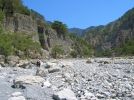 Since their uplift in the Miocene, the horst massifs of Crete have been incised by river systems, but Quaternary climate changes have also resulted in alluvial cut and-fill sequences in the deep valleys and gorges. Crete is in the Hellenic plate boundary region - the most tectonically-active area of Europe. Sea-level marks up to 9m above sea level around the west Cretan coastline have been dated, and ascribed to the documented earthquake of AD 365 [the "Early Byzantine Tectonic Paroxysm" (Thommeret et al, 1981; Pirazzoli, 1986)]. This project investigates the contributions of this sudden uplift event and climate change in the late Holocene on the development of systems in western Crete.
Since their uplift in the Miocene, the horst massifs of Crete have been incised by river systems, but Quaternary climate changes have also resulted in alluvial cut and-fill sequences in the deep valleys and gorges. Crete is in the Hellenic plate boundary region - the most tectonically-active area of Europe. Sea-level marks up to 9m above sea level around the west Cretan coastline have been dated, and ascribed to the documented earthquake of AD 365 [the "Early Byzantine Tectonic Paroxysm" (Thommeret et al, 1981; Pirazzoli, 1986)]. This project investigates the contributions of this sudden uplift event and climate change in the late Holocene on the development of systems in western Crete.

